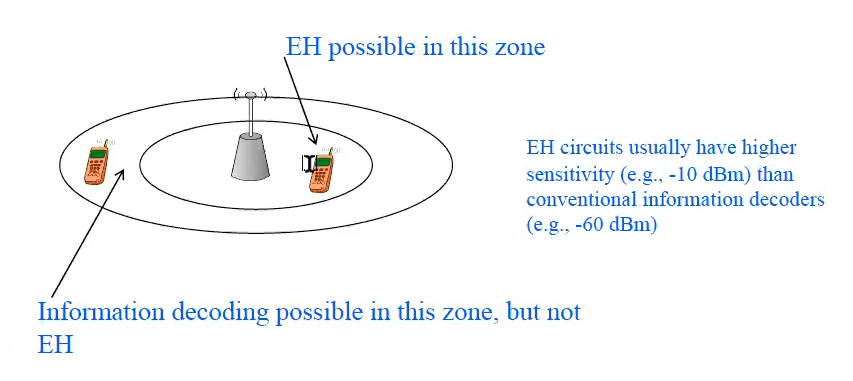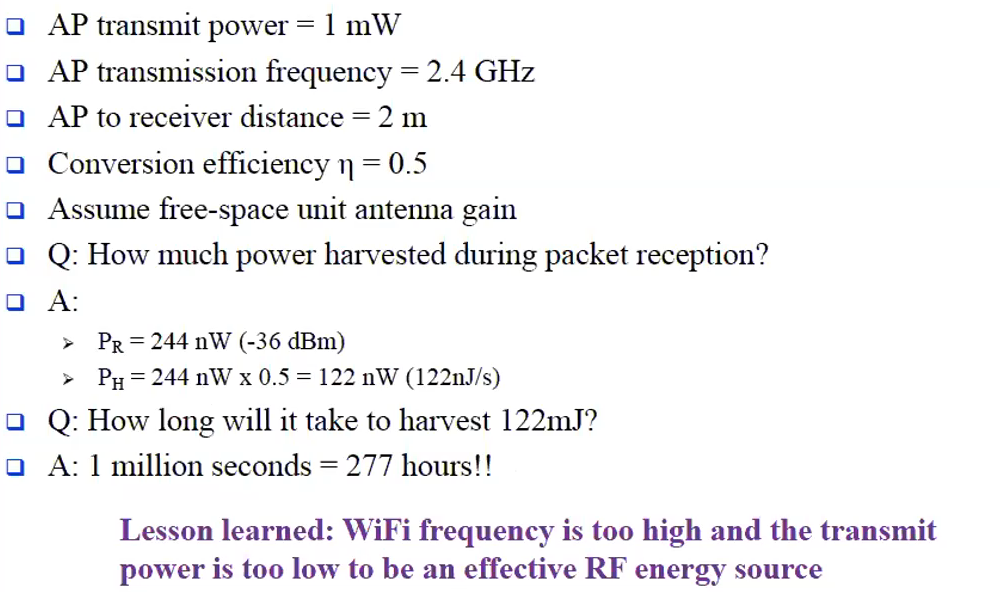Wireless Power Transfer and Sensing
Contents
Uses of RF
- Can be used for wireless communication
- Can be used for wireless power transfer
- Can be used for sensing - remote sensing of humans and other phenomena
SWIPT
Simultaneous Wireless Information and Power Transfer
Can transfer power wirelessly (remotely powered toy helicopter!)
- Ambient source - TV, Radio, Cellular towers
- Dedicated - Static RF sources, Mobile sources, Hybrid sources
Example devices: Powercast - 915 MHz TX91501
Energy harvesting (EH) often requires -10 dBm sensitivity, whilst information decoding is possible even at -60 dBm.

Out of Band EH
- Separate frequencies are used for energy and communication
- Requires separate antennas
In-Band EH
- Same RF signal used for both energy and communication
However, we can only perform one operation at a time on the signal.
- separate antennas
- time switching - switch between energy and communication use
- power splitting - split the signal into two weaker signals
Separate Antenna
Device will be larger due to having two antennas, and also the distance from the placement of the antennas.
Will also be more costly.
- Entire signal power available for energy harvesting
- $ P_H = P_R \times \eta $
- $\eta$ is the RF-DC conversion efficiency (ratio)
- No additional noise for information processing
- $C = Wlog(1+P_R/P_N)$
- $P_N$ is the thermal/antenna noise
Time Switching
Device will switch between energy harvesting and information decoding.
Consequently, operation will only be able to use half of the total available time
- Entire signal power available for energy harvesting
- $ P_H = P_R \times \eta $
- $\eta$ is the RF-DC conversion efficiency (ratio)
- No additional noise for information processing
- $C = Wlog(1+P_R/P_N)$
- $P_N$ is the thermal/antenna noise
Power Splitting
Both EH and ID can occur at the sime time, but energy is lost.
- Entire signal power available for energy harvesting
- $ P_H = P_R \times \theta \times \eta $
- $\theta$ is the fraction of received signal used for EH
- $\eta$ is the RF-DC conversion efficiency (ratio)
- Additional signal processing noise
- $C = Wlog(1+P_R\frac{1-\theta}{P_N+P_{SP}})$
- $P_SP$ is the power of signal processing noise
- $P_N$ is the thermal/antenna noise
Power to Energy
Power is the rate of energy (joules per second).
$$ E_H = P_H \times T $$
However, $P_H$ may vary over time - interference, distance, etc
$$ E_H = \sum_i P_{H_i} \times T_i $$
Depending on the $\eta$ value (RF-DC conversion efficiency), we will actually have less usable power than that!
i.e at $-60\ dBm$, $\eta = 0.5$ ... We only have $500\ pW$ of usage power.
$10^{-6} \times 0.5 = 500\ pW$
Can a WiFi AP be used as an ambient source?

RF Sensing
- Activity Recognition
- Gesture Recognition
- Fall Detection

Metrics
- RSS - Received Signal Strength - Average signal amplitude
- CSI - Channel State Information - Detailed amplitude and phase
- TOF/TOA - Time of Flight/Arrival - Range
- Doppler Shift - Velocity
Channel State Information
$$ y = h(x) + n $$
CSI estimation involves estimating $h$.
$$ Ae^{j\theta} $$
- $\theta$ - phase
- $j$ = $\sqrt{-1}$
$$ a+jb $$
- amplitude = $\sqrt{a^2 + b^2}$
- phase = $tan^{-1} \frac{a}{b} $
Can be used for Human sensing, with a CSI time series
CSI is used in the PHY layer, to help wireless devices switch the best channel and data rates.
Software like nexmon can be used to extract the CSI values
Time of Flight / Time of Arrival
Range = TOF x Speed of Light
RADAR application - FMCW
Frequency Modulated Continuous Wave
A radio wave is emitted with a linear chirp.
Linear Chirp - frequency increase at a known constant rate.
The transmitter and receiver are both located on the same hardware.
By detecting the received frequency and time taken to receive the signal, we can calculate the distance.
We can even detect multiple signals - allowing us to detect multiple objects.
Doppler Effect
Doppler Effect - frequency changes depending on velocity
Radial velocity of different body parts can be obtained from the doppler shift.
$$ v = \frac{\Delta f \times c}{f} $$
- Using FFT, we can estimate the doppler and velocity from FMCW range data, and CSI (less accurate)